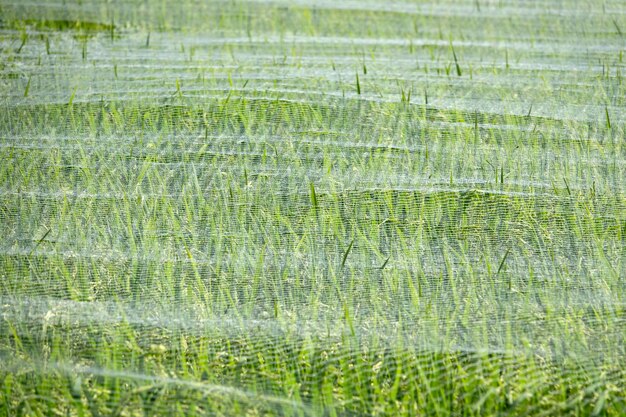Effective pest control is a critical aspect of modern agriculture, ensuring that crops remain healthy, productive, and free from the damage caused by harmful pests. Pests, including insects, rodents, fungi, and weeds, can severely impact crop yields and quality, leading to financial losses for farmers. Crop protection involves a variety of tools, techniques, and strategies to prevent, manage, and eliminate these pests. Here’s an overview of the most effective crop protection methods used today.
1. Chemical Control (Pesticides)
Chemical pesticides have long been the go-to solution for pest control in agriculture. These chemicals are designed to target specific pests and prevent them from damaging crops. Pesticides are available in various forms, such as sprays, dusts, and granules, and can be used for insecticides (to control insects), herbicides (to control weeds), and fungicides (to control fungi).
Advantages:
- Quick and effective at reducing pest populations.
- Available for a wide range of pests, including insects, weeds, and diseases.
- Can protect crops for extended periods of time.
Challenges:
- Over-reliance on pesticides can lead to resistance in pest populations, making them harder to control.
- Pesticides can negatively affect beneficial insects like pollinators and natural predators.
- The environmental impact of chemical runoff and soil degradation is a concern.
2. Biological Control
Biological control, or biocontrol, uses natural predators, parasites, or pathogens to control pest populations. This method is environmentally friendly and sustainable, as it targets specific pests without harming the wider ecosystem.
Examples:
- Introducing ladybugs to control aphids.
- Using parasitic wasps to control caterpillars or moth larvae.
- Applying beneficial nematodes to target soil-dwelling pests like rootworms.
Advantages:
- Environmentally friendly and sustainable.
- Reduces reliance on chemicals, leading to healthier ecosystems.
- Can offer long-term pest control solutions.
Challenges:
- Requires knowledge of the pest’s lifecycle and the appropriate natural enemy.
- Sometimes slower to show results compared to chemical control.
- May not be effective in all situations, particularly with highly invasive pests.
3. Cultural Practices
Cultural practices involve changing the farming environment to make it less conducive to pest populations. These practices often work in tandem with other pest control methods and can be highly effective when used as part of an integrated pest management (IPM) strategy.
Examples:
- Crop Rotation: Changing the types of crops grown in a particular field each season can help disrupt pest life cycles. For example, rotating crops like corn with legumes can help reduce pests that prefer a particular plant species.
- Trap Cropping: Growing a secondary crop that attracts pests away from the main crop, which can then be treated or removed.
- Tillage: Proper soil management through tilling can reduce pest populations, particularly for pests that live in the soil, such as grubs or rootworms.
Advantages:
- Reduces the need for chemical interventions.
- Can enhance soil health and improve crop yields.
- Encourages a more diverse farming system.
Challenges:
- Requires careful planning and knowledge of pest behaviors.
- May not provide immediate results.
- Can be labor-intensive or require additional land and resources.
4. Physical and Mechanical Control
Physical and mechanical control techniques use physical barriers or actions to prevent pests from accessing crops. These methods are particularly useful for managing insect pests or rodents that can be physically excluded from crops.
Examples:
- Insect Netting: Fine mesh netting can be used to protect crops from insects such as aphids, whiteflies, or fruit flies.
- Fences and Traps: Rodent control can be achieved by setting up fences or using traps that catch or repel pests like rats, rabbits, and birds.
- Mulching and Row Covers: Organic mulches can prevent weed growth, while row covers can protect crops from insects and extreme weather conditions.
Advantages:
- Non-toxic and environmentally safe.
- Immediate and visible results in controlling pest access.
- Can be applied to small or large-scale farming.
Challenges:
- Labor-intensive and may require ongoing maintenance.
- May not be feasible for all types of pests.
- Can be costly to install and maintain for large-scale operations.
5. Integrated Pest Management (IPM)
Integrated Pest Management (IPM) is a holistic approach that combines multiple pest control strategies to reduce the impact of pests while minimizing harm to the environment, human health, and non-target organisms. IPM involves monitoring pest populations, setting action thresholds, and using a combination of cultural, biological, physical, and chemical controls in a way that is both effective and sustainable.
Key Principles of IPM:
- Monitoring and Early Detection: Regular scouting of fields to detect pest populations before they reach damaging levels.
- Thresholds: Setting action thresholds for pest populations, so that control measures are only implemented when necessary.
- Prevention: Using crop rotations, resistant varieties, and proper field sanitation to prevent pest problems from occurring.
- Control Methods: Applying a combination of control methods, including mechanical, biological, and chemical, based on the pest problem at hand.
Advantages:
- Reduces the reliance on chemical pesticides.
- Encourages long-term sustainability and resilience against pests.
- Promotes biodiversity and environmental health.
Challenges:
- Requires knowledge and expertise to monitor and manage pests effectively.
- May have higher upfront costs for implementation.
- Can be time-consuming, particularly in large-scale operations.
6. Genetic Engineering and Biotechnological Solutions
Advancements in genetic engineering and biotechnology have led to the development of genetically modified (GM) crops that are resistant to specific pests. These crops are engineered to produce their own pest-resistant compounds, reducing the need for chemical interventions.
Examples:
- Bt Crops: Crops such as Bt cotton and Bt corn produce proteins from the bacterium Bacillus thuringiensis, which is toxic to specific insect pests but harmless to humans and animals.
- Pest-Resistant Varieties: Crops have been genetically modified to be resistant to specific pests, reducing crop damage and the need for pesticides.
Advantages:
- Reduces the need for chemical pesticides.
- Can result in higher yields and lower production costs.
- Improves resistance to pest damage and increases crop durability.
Challenges:
- There are concerns about the long-term environmental impact of GM crops.
- Pest resistance to genetically modified traits may develop over time.
- Controversy and regulatory hurdles surrounding the use of GM crops in certain regions.
Effective pest control is essential for maximizing crop yields and ensuring sustainable agricultural practices. By utilizing a combination of tools and techniques, such as chemical control, biological control, cultural practices, physical methods, and integrated pest management, farmers can protect their crops from pests while minimizing environmental impact. The key to successful crop protection lies in adopting a balanced, multifaceted approach that aligns with the specific needs of the farm and its ecosystem, ensuring long-term productivity and sustainability.
Join 'Farmers Mag' WhatsApp Channel
Get the latest Farming news and tips delivered straight to your WhatsApp
CLICK HERE TO JOIN






